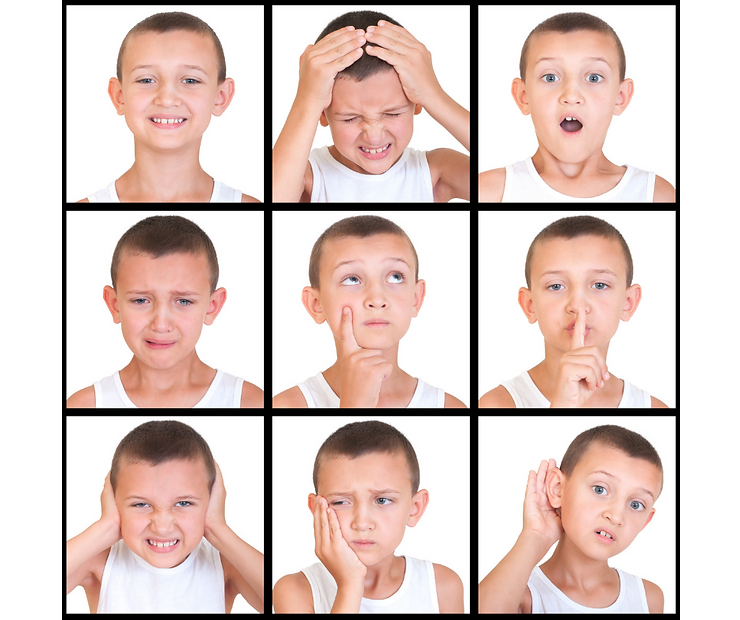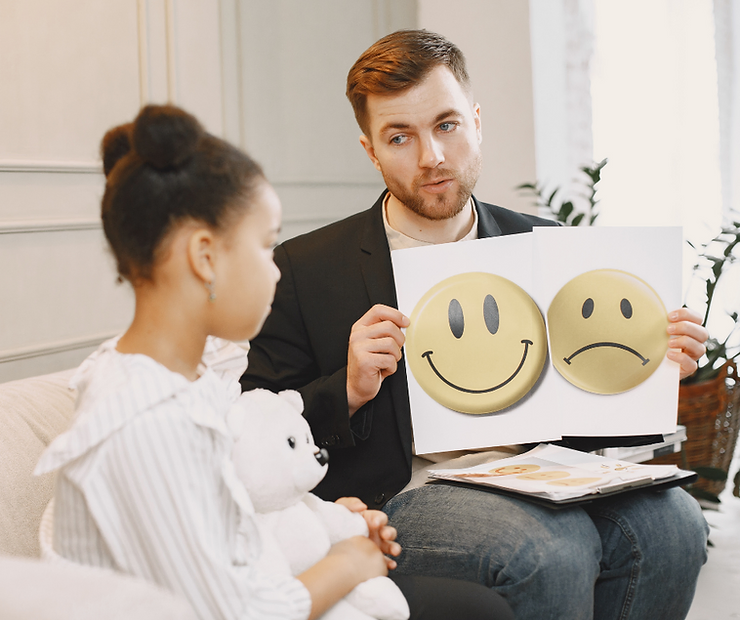How to Manage Your Child’s Emotions
December 6th, 2022Your Child Can Feel Better With These Simple Tips!

1. Set up a Routine: Make sure backpack, clothes & homework are ready the night before. Have a family meal time or family fun time each day. Let your child know the plans for the next day.
2. Stay Calm: Even if your child is begging you, crying & melting down. Your child can sense your anxiety. Put on your “Game Face” and remain positive. Focus on your child’s strengths instead of their weaknesses. Help them follow through with their obligations whether it is with a playdate, school, church, or home.
3. Do NOT avoid your child’s fears: Help your child face their fears. Avoiding the “thing” that causes your child’s fear will only make it worse! Letting your child stay home from school because they don’t want to be away from you will only make it harder the next time. There may be tears, tantrums & sad faces but know that with time then that will go away. The best way to conquer anxiety is to face anxiety!
4. Be Prepared: Making sure that your child’s homework is done, tests are studied for & materials ready will help ease their anxiety. Many times, students are not wanting to come to school because their homework is not done & missing more school will only increase that worry adding upon their stress. Whatever your child’s fear is, you can help them feel more prepared and confident.
5. Teach your child strategies: Children can be taught strategies at a young age to help deal with their anxiety. They will need your help & guidance on how to use these strategies because children won’t know how or when to use them on their own. Strategies include deep breathing, fidget or sensory toys, positive self-talk, & relaxation or mindfulness methods.
6. Cut down Screen Time: Studies show that our screen time increases anxiety and depression and decreases social skills. Your child should have a maximum of 45-60 min of screen time a day (This does not include screen time for school or homework)! Use technology as a tool rather than a distraction. Encourage them to go outside and play.
7. Good Sleep: Make sure that your child is getting enough sleep at night. A good bedtime for elementary students is 8:30. This allows them to at least get 10-12 hours of sleep. Make sure they are not on electronics at least an hour before bedtime. This will help their brains relax and regulate their melatonin levels, which helps them sleep better.
8. Healthy Diet: Our food is our fuel. Studies show junk food increases anxiety and depression. If our children aren’t eating healthy, they won’t be able to function. They will be more restless, anxious & emotional. Healthy food will improve anxiety and depression.
Resources for Anxiety and other Emotions

Technique’s
Any Mindfulness technique could be helpful. You can use these or google different ones
Techniques: Any Mindfulness technique could be helpful. You can use these or google different ones
● The Color Game-Find everything in the room that’s a certain color, then go to the next color
● Come back to the 5 senses- example: 5 things you can see, 4 things you can hear, 3 things you can touch, 2 things you can smell, 1 thing you can taste
● Sing your thoughts to the tune of Happy Birthday or say them in a funny voice (Like Minnie Mouse)
● Lock up your worries in a worry box in your mind, then set a worry time to open up the box and talk about your child’s worries
● Take deep breaths with your child In for 4 seconds, out for 4 seconds
● Tell your safety brain “That’s a lie” then tell your brain true information (ex: List the people at school who care about your child if your child is afraid of school)
● Give your child a stress ball or sensory toy to play with while they talk to you
● Imagine every detail of your happy place or memory like you were actually there
Books:
● Workbook to do with your child- What to do When you Worry too Much by Dawn Huebner or What to do When you don’t want to be apart by Kristen Lavallee, What to do When Fear Interferes, What to do when your temper flares, What to do When Mistakes Make you Quake, What to do when you Grumble too Much, What to do when Bad Habits Take Hold, etc (There is a whole series of these books for different emotions you can search What to do workbooks for kids)
● The Illustrated Happiness Trap by Russ Harris-Easy read for adults with some techniques to help the worries
● You can Google “Books to help kids with anxiety (or whatever emotion)” and a long list of helpful books come up
Websites:
● Mind yeti- guided mindfulness for kids https://mindyeti.com/power-portal
● Yogamedo youtube channel- Yoga for kids helps them learn some skills to de-stress
● www.cosmickids.com or Cosmic Kids.com on youtube
● Worry Wise Kids-Info on anxiety for parents www.worrywisekids.org
● NAMI- Info on anxiety https://www.nami.org/
● Google “mindfulness techniques for kids” online
● Youtube relaxing music with fish on youtube- Have your child focus on the fish when upset
Free Apps:
● Relaxio (White noise app)
● Stop, Breathe, and Think (guided mindfulness app based on your mood)
● Headspace (General guided mindfulness/meditation app)
● Mind yeti app (Goes along with the website mentioned above)
● Mindful Family
● Insight Timer
● Smiling mind
● My Strength- free classes, tips, and trackers for mental and physical well-being
● SafeUT- 24/7 therapists you can call, text, or chat with- you can also send in tips of someone who may need help
Community Resources:
● SAFE-FAM- Free Mobile Response and Stabilization services for any child or caregiver ○ 1(833) SAFE-FAM (723-3326)- They come into your home and work with your child for free ● Call 2-1-1 for more resources for children and adults
8 Mindfulness Activities You Can Do as a Family

Mindfulness is a simple, yet powerful way to relieve stress and help with emotional regulation, and there are so many benefits for children and adults. You can practice mindfulness regularly (even if you are feeling good) to enhance the wellbeing of your family. Here are ten simple tricks you can try with your family (You can think of some of your own too!):
1. Take a listening walk Go someplace (backyard, nature, the mall, etc) and walk together in silence, listening for sounds you typically overlook: leaves rustling, a pine cone falling from a tree, your own steady breath. To make it more fun, you can turn paper cups into amplifiers by cutting a hole in the sides of two cups and putting them over your ears.
2. Take a 30 second vacation Imagine every detail of where you want to go on vacation (can also be your happy place or a happy memory) as if you were actually there in your mind. What can you see, taste, touch, and smell while you are there? You can do this as long as you would like.
3. Savor some silence During a period of enforced quiet, go through your regular routine, and see what you hear, see, smell, and feel in the silence.
4. Try a sitting meditation A formal meditation can be difficult for kids (and adults!). But it is very effective— The most common form of meditation is to focus on the breath. You can have your family focus on their breathing, or find a guided meditation on an app or website (Stop, Breathe, and Think, Mind Yeti, Insight Timer, Headspace, Smiling Mind, and Mindful Family are a few.)
5. Play the Color Game While you are walking outside or sitting inside, you can play the color game with your children. Find everything in the area that is a certain color, then you can go to the next color. You can also play this game with patterns (stripes, polka dots, lines, etc) numbers, letters, and shapes. This game helps calm the mind and bring us back to the present.
6. Really taste what you’re eating Be in the present moment with the taste, textures, and temperature of foods that you are eating. Focus on how it feels to chew or sip in your mouth. Ask everyone to spend the first few minutes of certain meals silently noticing the food in their mouth. If your mind wanders to something else, simply bring it back to the present moment.
7. Listen Carefully/Spend Time Together Without distractions like TV, social media, phones, or electronics, be fully engaged as you listen to each other and spend time with each other. Notice how you feel about each other when you do this.
8. Notice your body A “body scan” is a great way to notice how your body feels in the present moment. Sit or lie with your kids and, starting with the toes, silently or out loud bring awareness to one body part, until you’ve worked your way up to the top of your head. If you want, you can have each person describe how a specific body part feels (ex: “I’m focused on my stomach, and it feels rumbly,” or “I’m focused on my left toes, and they feel tingly.”)
11 Tips to Parent Your Anxious Child by Anne Marie Albano, PhD

1. Respect and validate your child’s feelings. Anxiety is real and not pleasant.
2. Teach your child deep, slow breathing. This is an easy and very portable skill for self-soothing and calming.
3. Listen to your child and ask, “Tell me what you are thinking.” This will help to reveal scary thoughts and scenes that build up in your child’s mind.
4. Rather than swooping to reassure, ask your child, “How likely is (that thing you are afraid of) to happen?” You’ll be teaching them to challenge their anxious thinking.
5. Prompt your child with “Tell me some things you can do to handle this situation,” and help them to brainstorm rather than just giving them solutions. This will help them feel empowered.
6. Give up the idea of “mental health days,”“skip days,”“sleep with mom nights,” or other ways of avoiding feared situations. This just makes the anxiety stick more firmly and lead to further avoidance.
7. Encourage your child’s attempts to be brave, no matter how small they may seem to you. Use labeled praise such as “I’m so proud of you for sleeping in your own bed last night.”
8. Work with your child to outline small steps leading to a bigger goal.
9. Create opportunities for your child to practice being brave and coping, and then high-five their efforts.
10. Recognize when you are anxious and say aloud what you can do to calm down and solve the situation. You’ll be modeling coping for your child, but be mindful and don’t overshare your anxiety!
11. Use a feelings chart to talk about how you feel, and model it for your children, “I feel sad because I burnt dinner.”



